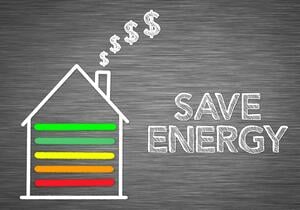Lowering our energy usage not only reduces our household energy costs, but it also contributes to lowering our carbon footprint.
When someone mentions being energy efficient in the home, the first thing many homeowners think of is appliances. Yes, when purchasing new appliances, you should certainly do your research and look for products with the Energy Star rating. If they have the Energy Star rating, count on them being 10 to 20 percent more energy efficient.
However, you don’t have to run out and replace all of your appliances to reduce your energy usage.
Here we take a look at a number of low-cost, easy ways to lower energy usage in our homes.
Decrease Your Water Usage:
Turn off the faucet when brushing your teeth. Shorten the length of your shower and be aware of how long you’re standing in the shower after washing. (You should also consider lowering your water temperature from hot to medium to reduce energy burned.) Run your dishwasher only when you have a full load and decrease the number of dishes you do by hand.
Shut Down That Computer:
Computers are high energy users in households and in businesses. In place of using sleep mode, get in the habit of powering off your computer when it’s not in use.
Go LED:
LED bulbs use 75 percent less electricity than traditional incandescent bulbs. Also, LED bulbs last approximately 25 percent longer than traditional incandescent bulbs.
Purchase a Power Strip:
Turning off all devices at once by using a power strip will help to avoid paying for “vampire power”. Vampire Power refers to the power being used by electronics that are continuously drawing power, even when not in use. Some examples of these electronics are computers, printers, chargers, etc.
Insulate:
Properly insulating your home will help to keep the cooler air in during the summer, and the warmer air in during the winter, allowing your cooling and heating systems to work more efficiently.
Install Room Darkening Shades:
Room darkening shades are a secondary way to help keep the cooler air in during the summer as they help prevent the sun from heating the inside of your home.
Rethink How You Use Your Cooling System:
When anticipating very hot and humid days, try running your air conditioning unit early to keep the house at a cooler temperature instead of turning it on after the temperature has increased, which makes the unit work harder to cool the area down. Alternatively, try to use ceiling fans instead of air conditioning on the days when the heat and humidity isn’t as bad, as they use much less energy to run.
Replace Weather stripping:
It’s estimated that up to 7 to 12 percent of a home’s heat loss is around windows and doors. Replacing worn weather stripping will help to insulate and keep the warmth in during the colder months.
Replace Your Thermostat:
You can cut your heating bill considerably by using a programmable thermostat. Turning down the temperature automatically when your away or while you sleep could allow you to save an estimated 10 to 15 percent on your heating bill. Since a programmable thermostat makes the adjustment automatically, you don’t need to worry about doing it when rushing out the door.
Though this list outlines just a small fraction of the things we can do as homeowners and consumers, practicing these low-effort behaviors is a great way to start to reduce your homes energy usage, which leads to saving money and the environment.

